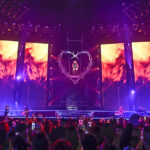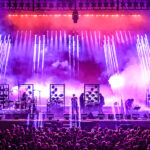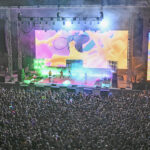
When he did his first Dick Clark’s New Year’s Rockin’ Eve at the Cocoanut Grove inside Los Angeles’ Ambassador Hotel in Dec. 1984, Lee Rose probably didn’t know that it would turn into a “thing.” He has, in fact, designed every one since, all with producer Larry Klein and director Barry Glazer. Counting a break in 2000 when the night was dedicated to millennium specials, “that’s 35 shows in 36 years,” Rose says. “That’s what you call a nice, regular client.”
Not much was regular about this year’s show, though. Just like everything 2020, plans kept evolving. The 350 audience/dancers they’d typically have went to zero, then edged back up with addition of nine high top tables with 2-4 “pods” of people per table. In addition to being distanced from each other, those audience members closest to the stage were still 20 feet out. The FOH riser, typically 32 by 12 feet, expanded to 70 by 24 feet. This made room for video people to be brought out as to cut down the number of those in the video truck. Through the years, it’s all taken place at various places, usually on a sound stage — and those weren’t available this year. Since no one was using the L.A. Convention Center, they went there.
“That space had advantages and disadvantages,” says Rose. “The producers like to pull talent from the American Music Awards happening at the same time, and since that show was next door at the Microsoft Theater, that was especially advantageous.” But his show’s 15,000 square-foot footprint was postage stamp-size compared to the 165,000 square feet of convention space they were in. “People had a lot of room to spread out, but it made for some long walks to the stages. And convention spaces are not designed for this kind of show. There is a strict limit on weight for rigging, so we had to support all the video screens with ground support towers.” Rose duplicated two stages and dressed them both with the same lights and video.
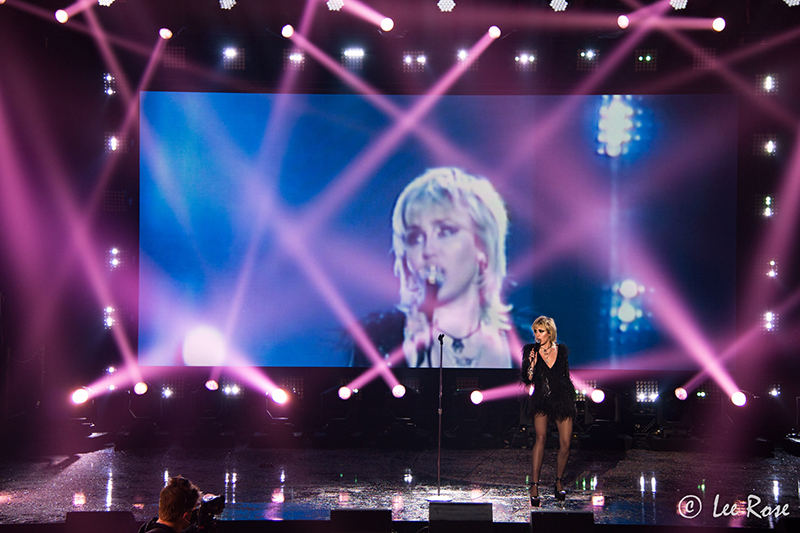
“The previous production designer for the show years ago showed up with a set model that had big holes in the wall, and the producer asked what goes in the holes,” says Lee. “The designer said, ‘Lee will put something in them.’ The first year of that set, we had gobos, which turned into projections, which turned into low-res video. At that point, we had walls of video, and it still fell to me to put something on the screen. Somehow I am still the guy running the screens.” Then low-res video became high-res video, and bands started showing up with their own content. This year, there was a plan to switch out the 10-year-old set, but with the pandemic and the uncertainty of what the show would look like, they stuck with the All Access Staging and Productions components they always rented. They again brought in Ayrton MagicPanels and placed them all the way around the main stage video screen.
PRG has been the lighting company for the event for many years. Tony Ward serves as Rose’s PRG account executive and handles either chief lighting technician or gaffer duties. “You get excellent customer service from the shop when the senior account executive is on your show,” Lee notes. PRG also provided the video screens (ROE CB5s) and Martin Phillips, who served as media director/programmer, supplied the Catalyst media servers. “I usually try to reach out to the manufacturers to see what kind of toys are out there, and they come up with some fixtures.” Martin Professional’s Brad Schiller also got Lee some fixtures, as did DeAnna Padgett and Tom Fonseca from Chauvet Professional. (In past years, Eric Loader of Elation has pitched in.) “It usually depends on what I see at LDI,” Lee says, with a laugh. This year’s toys included Chauvet’s Maverick MK Pyxis and Rogue Outcast Hybrids along with Martin MAC Allure Profiles, Allure Washes and Rush Scanner 1 LEDs.
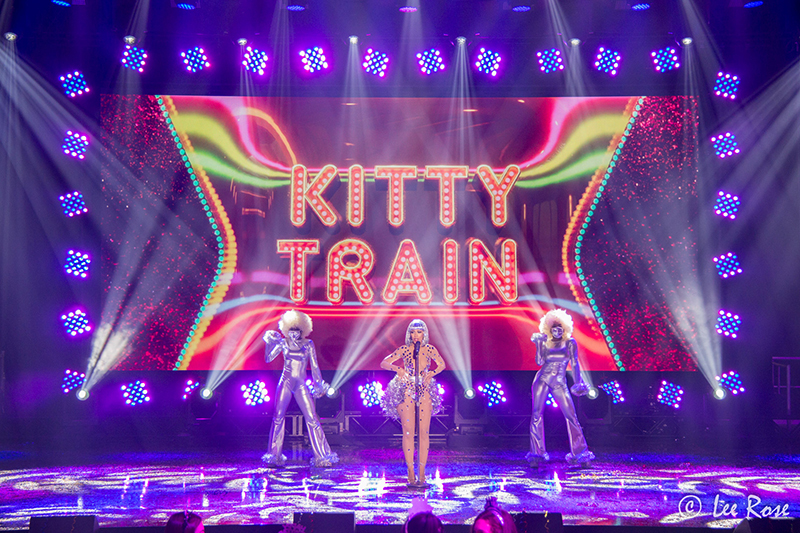
More Performances, More Looks, More Programming
A small live audience made for fewer cut-away shots. “That actually gave me a chance to have more camera shots of the stage than I normally do, which I liked,” Rose says. There were performances in Times Square, but not New Orleans as they typically do. This meant more performances on Rose’s stage — 36, up from 25. “That is a lot to get programmed. We get two 10-hour days to program, so that leaves eight or nine hours of programming each day if we’re lucky. Then we grab whatever time we can during setup and rehearsals.” He credits programmers Andy O’Reilly and Patrick Brazil for efficiently pulling it off. O’Reilly handled most of the stage lighting and Brazil also handled key lights and the MagicPanels. Patrick Adair was the art director and Joe Stewart was the production designer. “We try to keep track of it all and we’re careful not to lean too hard on any one color or look,” Rose says.
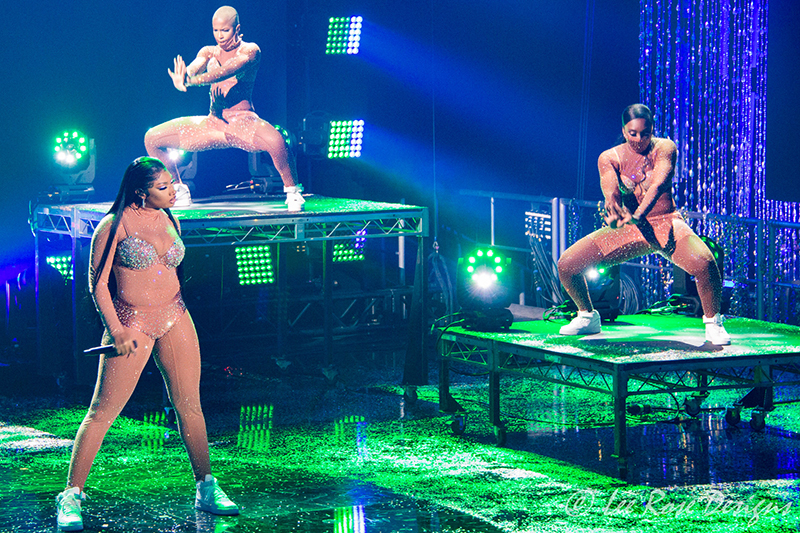
The quest for visual variety led to one particularly audacious look: He smothered Megan Thee Stallion and her dancers in green. “What I try to do is keep a running spreadsheet of what colors and looks can work, and the content of her act was pushing me in a direction to complement by contrast.” What colors are used on the acts before and after also influence his choices. For the ballad Lewis Capaldi sang, he wanted it to be as dramatic as possible. “They provided content of slow rolling storm clouds, and then it was just him and a piano.” He put a PRG Icon Edge downstage stage right on the floor as a key light and then shot it from stage left, something he’s not usually able to do. “I thought it had a great look.” Julia Michaels provided a starfield background, so he broke that up with black and white gobos and a silver mirror panel that gave it a sparkly, joyous look.
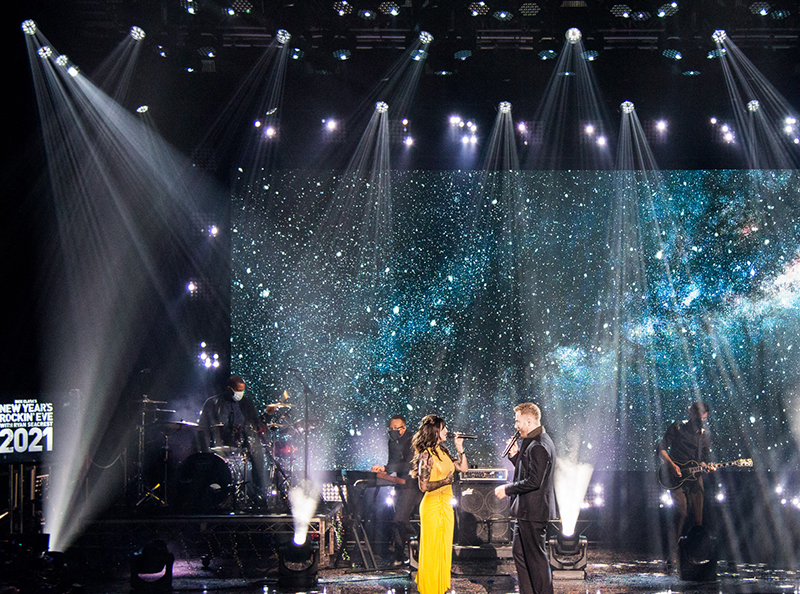
There was a little work after the show. Dick Clark Productions was going to stream a production of Doja Cat for something else and needed Rose to change the look dramatically — you know, something that was less New Year’s Rockin’ Eve-ish. “We turned off all the lights, flew a drape over the MagicPanels, used that Chauvet Outcast Rogue Hybrid, and made it work.” Dick Clark Productions being Dick Clark Productions … well, there was no extra pay for that. This is not unprecedented. In the mid 1980s, he was working on a music/variety/dance show for them, and Lee was told that Dick Clark himself had shot an intro for another show but didn’t like it. Now he wanted Rose and his then-partner Richard Oshen to reshoot it in the corner, away from the main show. Rose asked if he would get extra money for that. That answer was a big “no.” But through the long, successful relationship with the company, he says, “I got no complaints.”
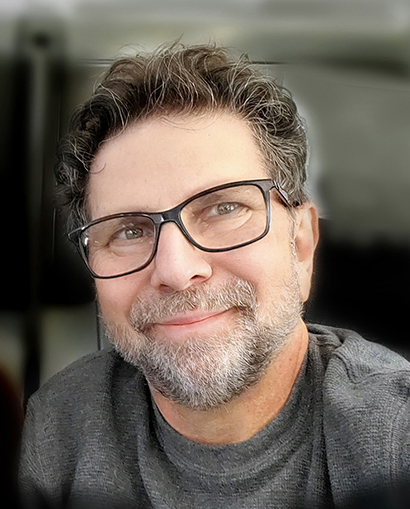
A Cleveland Kid
Rose grew up in Cleveland. His grandfather was a retired motion picture projectionist, and he has fond memories of being taken up those back stairs to the projectionist booth to visit grandpa’s old cronies. There he was intrigued by the arc of light that emanated out of the projector. In junior high, he figured out he could get out of English class by volunteering to go help with the children’s theater group that worked out of the school. “One of their productions was You’re a Good Man, Charlie Brown, which called for cartoon-like sets,” he tells. “I realized I couldn’t paint, and that’s when I started working with the lights.” His family left Ohio for Arizona for a year in 1969, and there the 15-year-old became an unpaid assistant to the lighting designer of a local theater. When that designer got a job in New York, the young teen got $150 for designing Anything Goes. “That was a lot of money for a teenager in 1970!” He was hooked.
Back in Cleveland, he started lighting local bands. His first major concert was designing lights for the prog-rock band Atlantis Philharmonic, which opened for Styx in 1974 (Jeff Ravitz was their LD at that time). Also during this time, he got in good with the famous Agora Theater. “They were doing rock concerts on Monday and jazz concerts on Tuesday,” he says. Then he met Andrew Polin, who was then Bob Morrissey’s partner at Polico Lighting. Polin was Boston’s original LD and Rose met him when the band played the Agora in 1976 — right when their first album exploded onto the scene. Cohen and Morrissey hired Rose to go on tour with them as an electrician. “We did 86 shows, and I think Polin fired me 84 times. Bob finally just told me to keep showing up and just stop talking to him.” Then Rose started getting to do some serious design work, going out with Johnny Winter, among others.
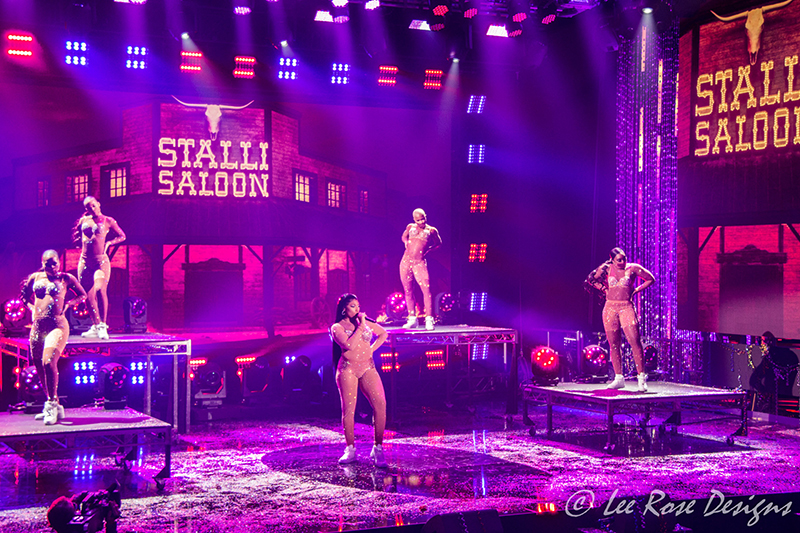
Meanwhile, Morrissey formed East Coast Lighting & Production Services (ECLPS) and Polin was replaced with Richard Oshen. When Boston’s second tour took off for 200 dates in 1978, Rose got the call to be head production/electrician. In rocked the 1980s, and Rose kept busy with Asia, Ted Nugent and Pat Travers. In a hint of things to come, he found himself working on a lot of those music videos happening at the time, often with Oshen. “Richard suggested we form a TV lighting company, and I told him I like touring, as the chicks are better,” Rose says with a wink. “Then he informed me that I did not want to be that 55-year-old f*ck with no wife who is still sleeping on buses.” With that perspective, the TV lighting company thing looked more palatable. In 1984, they formed Oshen, Rose & Associates.
They made a cold call to Dick Clark Productions asking to light Charlie Daniels’ Volunteer Jam, but got turned down. A call came shortly thereafter to bid for the first annual Black Gold Awards, which was hosted by Lou Rawls and held at the Cocoanut Grove. They got the gig, but it was they who got “got:” “We had never done our own TV show lighting package together, and we put a ‘competitive’ bid in, with me and Richard both being co-LDs and co-gaffers, because we both wanted the salaries. It wasn’t enough, and it ended up costing us like $500 to do the show.”
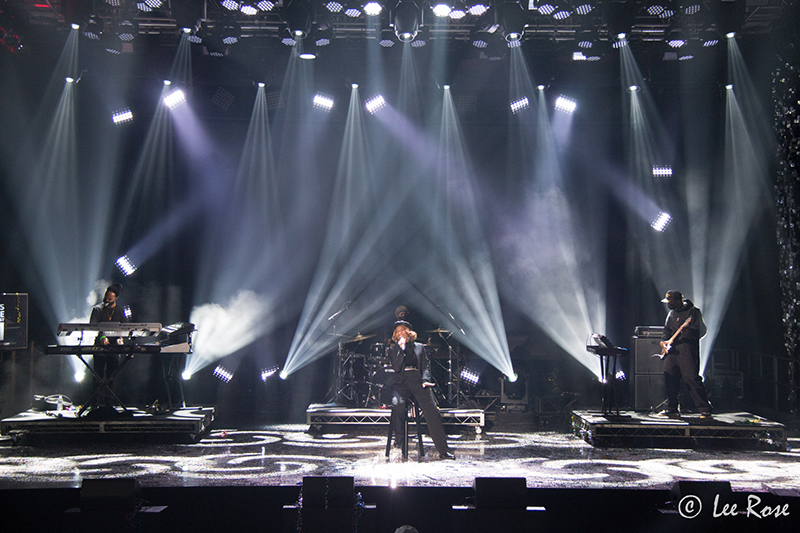
But it paid off in the long run. The team would do over 130 shows for Dick Clark Productions over the next 14 years. Clark’s reputation as being tight fisted with the money is something that Rose came to appreciate. “For us, it was TV Production 101,” he explains. “To say they were ‘economical’ is a nice way of saying they were tight, but their production skills were spot-on. Their team always had quality people.” They would do plenty of other big productions, too, including the Golden Globe Awards.
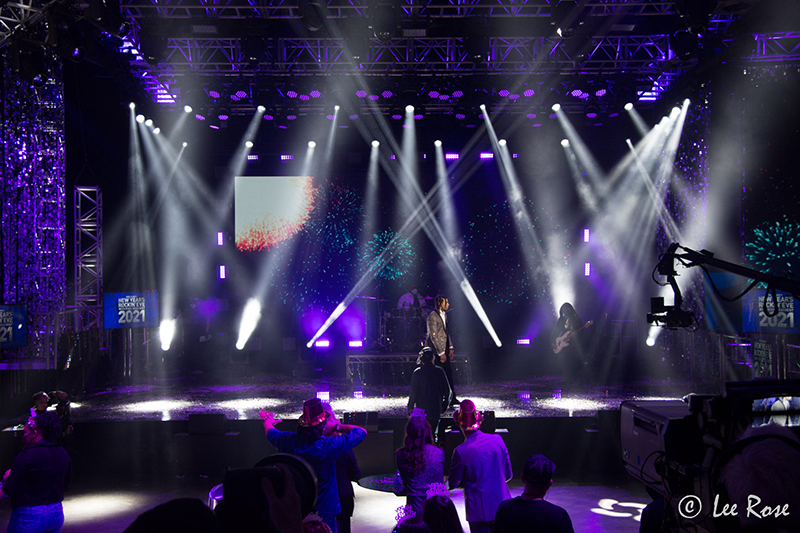
The team of Oshen and Rose had a good run, but in 1998 he got a call from Design Partners to come work for them. At first, he demurred, pointing out he likes his name on the door. But the company offered him a lot of perks including health insurance, an IRA, and “union” hours. “Like in the movie The Godfather, they made me an offer I couldn’t refuse.” Through the years, Rose kept doing the Dick Clark Productions gig and had a good run with the Jerry Lewis Telethons (both with and post Lewis). Along the way, he has done Disney specials; Christmas specials for Garth Brooks and Glen Campbell; comedy specials; and award shows, including the Revolver Golden God Awards, Daytime Emmy Awards and the Writers Guild Awards. He’s also received two Emmy Award nominations, both with his work on Yanni television specials.
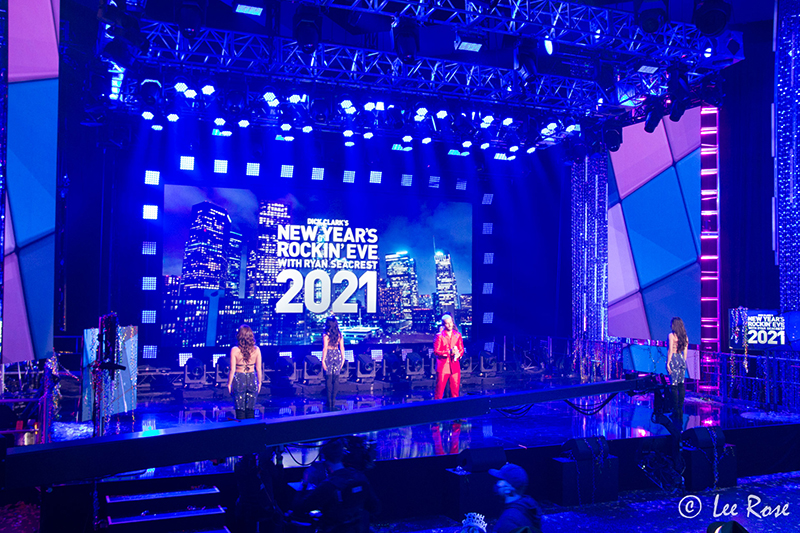
Rose has “officially” retired from the International Cinematographers Guild as of the first of this year. “I will probably still do a few little things that I still get calls for, but limiting myself to less than 50 hours per month.” As for Dick Clark’s New Year’s Rockin’ Eve in 2022: “If they call, we’ll talk.”
